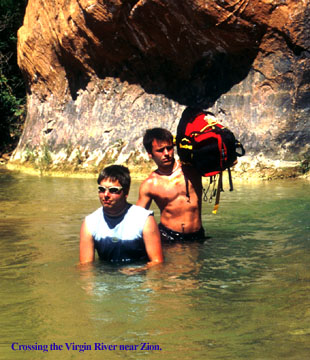|
|
 By Margie
Lehnardt
By Margie
LehnardtPhysical and mental preparation is required when planning a trip through one of these slot canyons. Canyoneering is not a walk in the park, but it can be done by just about anyone.
Because of the huge influx of interest in canyoneering, people tend to think that itís as simple as putt-putt golf. But before you load the kids into the minivan, there are a few inherent risks and dangers to be aware of and prepare yourself for. Sunburn, heat exhaustion, dehydration and minor injuries such as ankle sprains are among the most common risks. The canyoneering environment is often wet, so hypothermia can also grab ahold of the unsuspecting. Due to the solitude and distance from civilization, these problems can swell (sometimes literally!) into quite unpleasant emergencies.
Major dangers, which can almost always be avoided, include flash floods and unfamiliarity with equipment and/or rappelling techniques.
Flash floods most often occur during the afternoons in the late summer months. August 1997 brought a tragic moment for Lower Antelope Canyon in Arizona when 11 hikers were killed by tons of mud and debris washed into the narrow canyon by a flash flood following a summer storm.
How in the world can you predict a flash flood? The name seems to connote a complete suddenness and take-me-by-surprise quality. The best advice is to listen to the National Weather Systemís storm warnings, watch the weather on the news, and pay attention to the skies. If rumbling, angry clouds are looming, stay out of those funneling canyons.
Through his extensive experience with rappelling, rope courses, climbing and guiding groups through Utahís slot canyons, guru-canyonman Matt Moore (owner, founder and head guide of Desert Highlights, a Moab-based company specializing in guided canyoneering expeditions) has developed a certain reverence for the periodic gushes.
"Get yourself to a safe place, where youíll be high enough off the floor of the canyon, and youíll be able to enjoy it without fear. You can hear the roar of the flood rounding the canyon corners. When it starts raining and hailing, echoing off the tight walls surrounding you, itís the most beautiful sound ever."
If youíre not familiar with the technicalities of rappelling, belaying and climbing, not to mention uncharted territory, bring someone who is. Desert Highlights (800-747-1342) offers guided year-round tours through Utahís slot canyons, in locations near Arches, Zion and Canyonlands national parks. Expedition companies usually cover everything from equipment to lunches and offer geological, technical and mythological expertise that will assure you safety and fun on your tour.
It may seem obvious, but be sure to bring enough water for yourself and other travelers in your group. Dehydration is nothing to laugh at. During the hot summer months, loose, long-sleeve cotton shirts help deflect the sunís blistering rays and keep you cool. Swimming suits, wet suits, and, in the cold months, dry suits, are best for negotiating the water pockets of some of these canyons. Youíre best off with low-cut, soft hiking boots and cotton socks. Make sure you have your sunscreen as well year-round.
For those with the experience and proper training to explore technical slot canyons without the assistance of a guide, be certain to have your helmets, ropes, leather gloves, harnesses, rappel devices, webbing and a bolt kit with you and in good working order.
Most importantly, be sure to bring a solid frame of mind. In the case of a heated emergency far from help, keep your mind cool and your actions calm. Says Matt, "All the ropes in the world arenít going to do you a bit of good if youíve got problems, but clear thinking and enough preparation will."
As you head into these mysterious canyons, breathe deeply of the cool canyon air and notice the colors, lighting and wildlife around you. True, there are dangers, but with the right amount of preparation and knowledge, these can easily be avoided and you can enjoy one of the most enjoyable sports the desert Southwest has to offer.